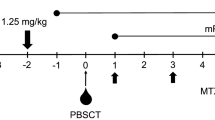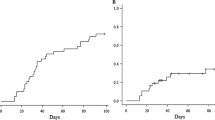Abstract
Although antithymocyte globulin (ATG) had been widely used in hematopoietic stem cell transplantation from unrelated donor due to its ability to prevent acute and chronic graft-versus-host disease (GVHD), the comparative efficacy and safety of ATG-Thymoglobulin (ATG-T) and ATG-Fresenius (ATG-F) in patients undergoing HLA-mismatched allogeneic peripheral blood stem cell transplantation from unrelated donors (UR-PBSCT) has not been evaluated. Retrospective analysis of patients who underwent HLA-mismatched UR-PBSCT between January 2003 and December 2013 and received pre-transplant ATG-T at a total dose of 10 mg/kg or ATG-F at a total dose of 20 mg/kg was performed. Patients who received ATG-T (n = 23) or ATG-F (n = 28) had similar baseline demographic, disease, and transplant characteristics. There were no significant between-groups differences in the probability of acute GVHD (P = 0.721) and chronic GVHD (P = 0.439). ATG-F was associated with nonsignificant trends toward higher disease-free survival at 3-year follow-up compared with ATG-T (45.7 ± 11.1 vs 61.3 ± 9.7 %, respectively, P = 0.07). A significantly greater proportion of ATG-T patients experienced high fever than ATG-F patients (P < 0.01) during ATG infusion. There was no difference in the rate of infection between the two treatment groups. There were less adverse effects comparing ATG-F with ATG-T. ATG-T at a total dose of 10 mg/kg and ATG-F at a total dose of 20 mg/kg had a similar clinical outcome in the setting of HLA-mismatched UR-PBSCT.



Similar content being viewed by others
References
Valcárcel D, Sierra J, Wang T, Kan F, Gupta V, Hale GA, et al. One-antigen mismatched related versus HLA-matched unrelated donor hematopoietic stem cell transplantation in adults with acute leukemia: Center for International Blood and Marrow Transplant Research results in the era of molecular HLA typing. Biol Blood Marrow Transplant. 2011;17(5):640–8.
Cheuk DK. Optimal stem cell source for allogeneic stem cell transplantation for hematological malignancies. World J Transplant. 2013;3(4):99–112.
Anasetti C, Logan BR, Lee SJ, et al. Peripheral-blood stem cells versus bone marrow from unrelated donors. N Engl J Med. 2012;367(16):1487–96.
Bacigalupo A. Matched and mismatched unrelated donor transplantation: is the outcome the same as for matched sibling donor transplantation? Hematology Am Soc Hematol Educ Program. 2012;2012:223–9. doi:10.1182/asheducation-2012.1.223.
Pidala J, Tomblyn M, Nishihori T, et al. ATG prevents severe acute graft-versus-host disease in mismatched unrelated donor hematopoietic cell transplantation. Biol Blood Marrow Transplant. 2011;17(8):1237–44.
Sheng Z, Ma H, Pang W, Niu S, Xu J. In vivo T-cell depletion with antithymocyte globulins improves overall survival after myeloablative allogeneic stem cell transplantation in patients with hematologic disorders. Acta Haematol. 2013;129(3):146–53.
Gaber AO, Monaco AP, Russell JA, Lebranchu Y, Mohty M. Rabbit antithymocyte globulin (thymoglobulin): 25 years and new frontiers in solid organ transplantation and haematology. Drugs. 2010;70(6):691–732.
Mueller TF. Thymoglobulin: an immunologic overview. Curr Opin Organ Transplant. 2003;8:305–12.
Kumar A, Mhaskar AR, Reljic T, et al. Antithymocyte globulin for acute-graft-versus-host-disease prophylaxis in patients undergoing allogeneic hematopoietic cell transplantation: a systematic review. Leukemia. 2012;26(4):582–8.
Penack O, Fischer L, Gentilini C, et al. The type of ATG matters: natural killer cells are influenced differentially by Thymoglobulin Lymphoglobulin and ATG-Fresenius. Transpl Immunol. 2007;18(2):85–7.
Ayuk F, Diyachenko G, Zabelina T, et al. Anti-thymocyte globulin overcomes the negative impact of HLA mismatching in transplantation from unrelated donors. Exp Hematol. 2008;36(8):1047–54.
Huang WR, Li HH, Gao CJ, et al. Unmanipulated HLA-mismatched/haploidentical peripheral blood stem cell transplantation for high-risk hematologic malignancies. Transfusion. 2012;52(6):1354–62.
Sullivan KM. Graft-versus-host disease. In: Blume KG, Forman SJ, Appelbaum FR, editors. Thomas’ hematopoietic Cell transplantation. 3rd ed. Malden: Blackwell Publishing Ltd; 2004. p. 633–64.
Shin SH, Yoon JH, Yahng SA, et al. PBSC vs BM grafts with myeloablative conditioning for unrelated donor transplantation in adults with high-risk ALL. Bone Marrow Transplant. 2014;49(6):773–9.
Pidala J. Graft-vs-host disease following allogeneic hematopoietic cell transplantation. Cancer Control. 2011;18(4):268–76.
Remberger M, Svahn BM, Hentschke P, Lofgren C, Ringden O. Effect on cytokine release and graft-versus-host disease of different anti-T cell antibodies during conditioning for unrelated haematopoietic stem cell transplantation. Bone Marrow Transplant. 1999;24(8):823–30.
Basara N, Baurmann H, Kolbe K, et al. Antithymocyte globulin for the prevention of graft-versus-host disease after unrelated hematopoietic stem cell transplantation for acute myeloid leukemia: results from the multicenter German cooperative study group. Bone Marrow Transplant. 2005;35(10):1011–8.
Bacigalupo A, Lamparelli T, Bruzzi P, et al. Antithymocyte globulin for graft-versus-host disease prophylaxis in transplants from unrelated donors: 2 randomized studies from Gruppo Italiano Trapianti Midollo Osseo (GITMO). Blood. 2001;98(10):2942–7.
Schleuning M, Gunther W, Tischer J, Ledderose G, Kolb HJ. Dose-dependent effects of in vivo antithymocyte globulin during conditioning for allogeneic bone marrow transplantation from unrelated donors in patients with chronic phase CML. Bone Marrow Transplant. 2003;32(3):243–50.
Remberger M, Svahn BM, Mattsson J, Ringden O. Dose study of thymoglobulin during conditioning for unrelated donor allogeneic stem-cell transplantation. Transplantation. 2004;78(1):122–7.
Duval M, Pedron B, Rohrlich P, et al. Immune reconstitution after haematopoietic transplantation with two different doses of pre-graft antithymocyte globulin. Bone Marrow Transplant. 2002;30(7):421–6.
Meijer E, Cornelissen JJ, Lowenberg B, Verdonck LF. Antithymocyteglobulin as prophylaxis of graft failure and graft-versus-host disease in recipients of partially T-cell-depleted grafts from matched unrelated donors: a dose-finding study. Exp Hematol. 2003;31(11):1026–30.
Ayuk F, Diyachenko G, Zabelina T, et al. Comparison of two doses of antithymocyte globulin in patients undergoing matched unrelated donor allogeneic stem cell transplantation. Biol Blood Marrow Transplant. 2008;14(8):913–9.
Remberger M, Storer B, Ringden O, Anasetti C. Association between pretransplant Thymoglobulin and reduced non-relapse mortality rate after marrow transplantation from unrelated donors. Bone Marrow Transplant. 2002;29(5):391–7.
Finke J, Bethge WA, Schmoor C, et al. Standard graft-versus-host disease prophylaxis with or without anti-T-cell globulin in haematopoietic cell transplantation from matched unrelated donors: a randomised, open-label, multicentre phase 3 trial. Lancet Oncol. 2009;10(9):855–64.
Waller EK, Langston AA, Lonial S, et al. Pharmacokinetics and pharmacodynamics of anti-thymocyte globulin in recipients of partially HLA-matched blood hematopoietic progenitor cell transplantation. Biol Blood Marrow Transplant. 2003;9(7):460–71.
Pihusch R, Holler E, Muhlbayer D, et al. The impact of antithymocyte globulin on short-term toxicity after allogeneic stem cell transplantation. Bone Marrow Transplant. 2002;30(6):347–54.
Acknowledgments
The authors wish to acknowledge all the physicians, nurses, and supporting personnel for their dedicated care of patients in this study. This study was supported by the Capital Health Research and Development of Special (No. 2011-5001-07).
Conflict of interest
The authors declare no conflict of interest.
Author information
Authors and Affiliations
Corresponding author
Rights and permissions
About this article
Cite this article
Huang, W., Zhao, X., Tian, Y. et al. Outcomes of peripheral blood stem cell transplantation patients from HLA-mismatched unrelated donor with antithymocyte globulin (ATG)-Thymoglobulin versus ATG-Fresenius: a single-center study. Med Oncol 32, 32 (2015). https://doi.org/10.1007/s12032-014-0465-y
Received:
Accepted:
Published:
DOI: https://doi.org/10.1007/s12032-014-0465-y




